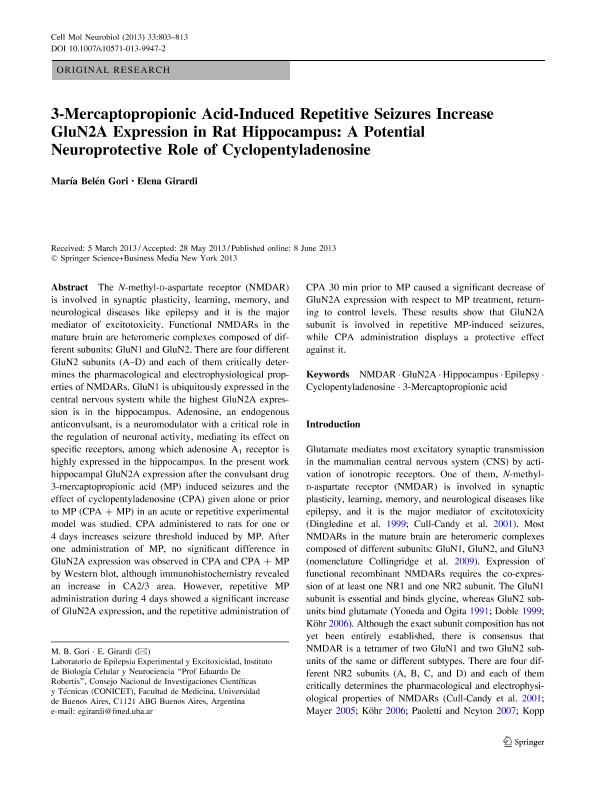Mostrar el registro sencillo del ítem
dc.contributor.author
Gori, María Belén

dc.contributor.author
Girardi, Elena Silvia

dc.date.available
2017-05-26T20:24:53Z
dc.date.issued
2013-08
dc.identifier.citation
Gori, María Belén; Girardi, Elena Silvia; 3-Mercaptopropionic acid-induced repetitive seizures increase GluN2A expression in rat hippocampus: a potential neuroprotective role of cyclopentyladenosine; Springer; Cellular And Molecular Neurobiology.; 33; 6; 8-2013; 803-813
dc.identifier.issn
0272-4340
dc.identifier.uri
http://hdl.handle.net/11336/17003
dc.description.abstract
The N-methyl-d-aspartate receptor (NMDAR) is involved in synaptic plasticity, learning, memory, and neurological diseases like epilepsy and it is the major mediator of excitotoxicity. Functional NMDARs in the mature brain are heteromeric complexes composed of different subunits: GluN1 and GluN2. There are four different GluN2 subunits (A–D) and each of them critically determines the pharmacological and electrophysiological properties of NMDARs. GluN1 is ubiquitously expressed in the central nervous system while the highest GluN2A expression is in the hippocampus. Adenosine, an endogenous anticonvulsant, is a neuromodulator with a critical role in the regulation of neuronal activity, mediating its effect on specific receptors, among which adenosine A1 receptor is highly expressed in the hippocampus. In the present work hippocampal GluN2A expression after the convulsant drug 3-mercaptopropionic acid (MP) induced seizures and the effect of cyclopentyladenosine (CPA) given alone or prior to MP (CPA + MP) in an acute or repetitive experimental model was studied. CPA administered to rats for one or 4 days increases seizure threshold induced by MP. After one administration of MP, no significant difference in GluN2A expression was observed in CPA and CPA + MP by Western blot, although immunohistochemistry revealed an increase in CA2/3 area. However, repetitive MP administration during 4 days showed a significant increase of GluN2A expression, and the repetitive administration of CPA 30 min prior to MP caused a significant decrease of GluN2A expression with respect to MP treatment, returning to control levels. These results show that GluN2A subunit is involved in repetitive MP-induced seizures, while CPA administration displays a protective effect against it.
dc.format
application/pdf
dc.language.iso
eng
dc.publisher
Springer

dc.rights
info:eu-repo/semantics/openAccess
dc.rights.uri
https://creativecommons.org/licenses/by-nc-sa/2.5/ar/
dc.subject
Nmdar
dc.subject
Glun2a
dc.subject
Hippocampus
dc.subject
Epilepsy
dc.subject
Cyclopentyladenosine
dc.subject
3-Mercaptopropionic Acid
dc.subject.classification
Neurociencias

dc.subject.classification
Medicina Básica

dc.subject.classification
CIENCIAS MÉDICAS Y DE LA SALUD

dc.title
3-Mercaptopropionic acid-induced repetitive seizures increase GluN2A expression in rat hippocampus: a potential neuroprotective role of cyclopentyladenosine
dc.type
info:eu-repo/semantics/article
dc.type
info:ar-repo/semantics/artículo
dc.type
info:eu-repo/semantics/publishedVersion
dc.date.updated
2017-05-26T14:44:04Z
dc.identifier.eissn
1573-6830
dc.journal.volume
33
dc.journal.number
6
dc.journal.pagination
803-813
dc.journal.pais
Estados Unidos

dc.journal.ciudad
Nueva York
dc.description.fil
Fil: Gori, María Belén. Consejo Nacional de Investigaciones Científicas y Técnicas. Oficina de Coordinación Administrativa Houssay. Instituto de Biología Celular y Neurociencia "Prof. Eduardo de Robertis". Universidad de Buenos Aires. Facultad de Medicina. Instituto de Biología Celular y Neurociencia ; Argentina
dc.description.fil
Fil: Girardi, Elena Silvia. Consejo Nacional de Investigaciones Científicas y Técnicas. Oficina de Coordinación Administrativa Houssay. Instituto de Biología Celular y Neurociencia "Prof. Eduardo de Robertis". Universidad de Buenos Aires. Facultad de Medicina. Instituto de Biología Celular y Neurociencia ; Argentina
dc.journal.title
Cellular And Molecular Neurobiology.

dc.relation.alternativeid
info:eu-repo/semantics/altIdentifier/url/https://link.springer.com/article/10.1007%2Fs10571-013-9947-2
dc.relation.alternativeid
info:eu-repo/semantics/altIdentifier/doi/http://dx.doi.org/10.1007/s10571-013-9947-2
Archivos asociados
